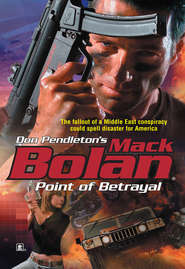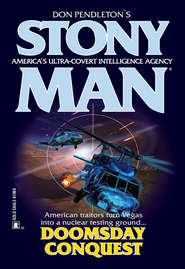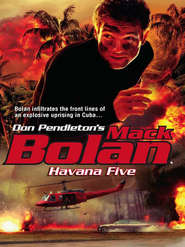По всем вопросам обращайтесь на: info@litportal.ru
(©) 2003-2024.
✖
Black Death Reprise
Автор
Год написания книги
2019
Настройки чтения
Размер шрифта
Высота строк
Поля
Bolan motioned with his pistol, said, “Open the door, or I’ll kill you and do it myself with your key card.”
Without hesitation, the man obeyed, using the magnetic card at the end of his lanyard to gain access.
The door opened into a cavernous modern facility approximately fifty feet square with vented work stations in every corner, large pieces of scientific equipment along the side walls, and an array of laboratory glassware that filled a series of shelves constructed from floor-to-ceiling against the back wall. Numerous beakers, flasks and spiral pipettes of various sizes were arranged on black slate-topped tables throughout the lab, creating the impression that an entire team of scientists was in the midst of conducting research.
A doorless frame leading into a free-standing room in the far corner of the lab was in the general area where Tokaido had told him there might be a stand-alone apartment, presumably for Dr. Zagorski.
As soon as Bolan heard the door close behind him, he rapped the guard at the base of his neck with the Beretta’s hand grip. The man exhaled heavily and went down like a sack of grain.
“Dr. Zagorski!” Bolan called out as he slipped a nylon tie wrap around the guard’s wrists, securing them behind his back.
A woman dressed in a dark blue night robe appeared in the open door frame, her disheveled reddish-brown hair testifying to the fact that she had been roused from sleep. Despite her rumpled appearance, Bolan recognized her immediately from the photos Hal Brognola had shown him at their initial meeting.
“Get me a weapon,” she said before dashing back into the room.
Bolan opened the door and grabbed one of the guards’ P-90 submachine guns leaning against the wall. As he was pulling back into the lab, the stairwell door he had used flew open, and four or five men dressed in identical gray jumpsuits charged forward, their automatic rifles spitting lead. Tossing the P-90 behind him into the lab, Bolan returned fire with his Beretta, catching the lead man in the chest with a 3-round burst. The steel-jacketed 9 mm rounds hammered him backward into the path of his oncoming comrades, who threw themselves to the floor in order to get out of the intruder’s line of fire.
Sonia Zagorski, fully dressed in jeans, running shoes and a forest green windbreaker with large flapped pockets in the front, ran to Bolan’s side as he slammed the door.
“Push this up against it,” she said, motioning to one of the heavy slate-topped work stations.
The ten-foot, four hundred pound unit was on casters, enabling them to position it against the door before locking the wheels in place.
“That won’t hold them for long,” she said while grabbing the P-90 from where it lay on the lab floor. Leaning over the fallen guard, who remained unconscious and breathing heavily, she relieved him of three full banana clips, shoving them into one of her windbreaker’s front pockets.
“Help me drag him over to the wall,” she said, grabbing the guard by a handful of fabric at the top of his shoulder. “He doesn’t have to die.”
Bolan nodded and they quickly shoved the limp man against the wall next to the door where he’d be away from the hail of bullets that was sure to commence momentarily.
“Do you have rope?” Zagorski asked, as if she was leading Bolan.
“Can you use that?” he replied, motioning to the submachine gun while pulling the grappling hook and cord from its pouch.
The attractive doctor, in whose hands a P-90 submachine gun looked out of place, deftly slid the bolt to the rear and released it, chambering the magazine’s first round.
“Let’s go,” she said, flipping the safety to its off position as the door began to disintegrate under a barrage of automatic fire from the guards on the other side.
The smell of cordite seeped into the lab to mix with the rising stink of combat and death, while the air filled with the chilling chatter of automatic weapons. The laboratory door started shattering in the center panel above the workbench, the hole growing wider under a steady torrent of bullets.
A gap appeared in the section above the slate-topped table, through which Bolan could see two men firing P-90s on full-auto. He responded with his Desert Eagle, the oversize handgun roaring in the lab’s enclosed space with ear-popping concussions as he hit the first gunman squarely in the chest. The heavy slug lifted him clean off his feet before slamming him into the wall on the other side of the corridor. He hung in place for a moment as if he had been tacked there by a giant entomologist, then slid slowly to the floor, leaving a messy red streak in his wake.
In the microsecond before the other guard had a chance to dive for cover, Bolan again squeezed the trigger. The round struck the guard in his chest inches below where he cradled the FNH submachine into his shoulder, exiting through a shattered shoulder blade. A spewing jet that included a handful of shredded tissue that moments earlier had been a section of the man’s beating heart splattered the distant wall. The force twirled him erratically out of control, his finger frozen in a death grip on the P-90’s trigger as he spun to the floor. For a few instants until his clip was exhausted and the firing pin clicked onto an open chamber, steel-tipped bullets flew randomly in all directions, the ones entering the lab ricocheting wildly off slate panels and scientific equipment before embedding themselves in the walls or ceiling.
Hot lead continued slicing the air, the altering trajectories of rounds whizzing through the opening in the door reflective of the shifting positions assumed by the gunmen outside as they scrambled to stay away from Bolan’s deadly line of fire.
Although their enemies’ efforts had so far been largely ineffective, the rounds flying through the laboratory like angry wasps were life-threatening to both Bolan and Zagorski. The situation was not progressing in their favor, and from all indications, it would get worse if they stayed where they were.
As if in response to Bolan’s thoughts, Zagorski leveled her submachine gun at the window and let loose with a 30-round clip while tracing the frame’s outline where it connected to the castle’s rock walls. The window was clearly a recent addition to the laboratory space, a wooden prefab unit that crumbled outward as neatly and cleanly as if it had been demolished by a team of licensed masons. The resultant wreckage sprayed a cascade of wood splinters and glass shards onto the narrow space between the monastery and the woods where Bolan had hidden the roving guards’ bodies, littering the tight area with deadly debris.
The window opening began receiving fire from down below, lethal lead adding to an increasing stream of bullets flying into the lab through the damaged door. Zagorski shoved the barrel of her weapon out the window, and without aiming fired her ammo in a steady burst that swept the area, forcing the guards to seek cover. When her first magazine was empty, she released the spent clip and in one fluid motion, grabbed a 30-rounder from her jacket pocket and shoved it into place while stealing a glance at Bolan. With one hand, he was securing the grappling hook to a heating pipe he was sure would support their weight, while with the other, he fired occasional rounds from the Desert Eagle to keep the guards on the other side of the door from mounting a charge.
Zagorski pressed herself as tightly as possible into the lower corner of where the window had been. Taking advantage of firing from a higher position than her enemies, she began practicing the very same elements of combat discipline Bolan had taught to hundreds of infantry soldiers around the world.
With the patience of a cat waiting for a chipmunk to emerge from under a log where it had disappeared five minutes earlier, Zagorski kept the edge of the barrel barely inside the room, out of sight from those on the ground while she peeked over the edge of the sill. One of the men below let his panic get the better of him and made a dash for what he perceived to be a more advantageous position. Zagorski engaged him with a well-aimed 3-round burst.
The gun’s sights had not been battle zeroed for her specific aim, causing the rounds she fired to fly almost a foot to the front and left of where she thought they would hit. The guard froze for a millisecond as he realized he was under attack, giving Zagorski the time she needed to realize the differential in the rifle’s sights. She immediately took corrective action by aiming slightly behind her target before letting fly with another quick burst of lead.
In the exact instant the stutter-stepping soldier dived for cover behind a gnarled clump of exposed maple tree roots, Zagorski’s rounds entered his lower back at a downward trajectory. The relatively flimsy 5.7 mm bullets traveled through his body in much the same way 5.56 mm NATO rounds could enter a man’s shoulder and exit through his thigh by tumbling along the skeletal frame while ripping through soft tissue. Zagorski’s rounds struck her victim at the base of his spine and moved upward, with at least one of them exiting through his neck as the combined force of the bullets shoved him violently to the ground.
Zagorski quickly pulled back behind the cover of the wall and scooted below the window to the other side of the opening while checking to make sure the ammo remaining in her magazine was adequate. Taking a deep breath and a few seconds to calm her nerves, she visualized where the other men had been in the split second when almost all her concentration had been on her target.
With the force of a coiled spring, she leaped upright, firing into the spot she had visualized. The tactic worked perfectly. A man standing behind a thin tree with a sawed-off shotgun held to his shoulder was staring at the opposite side of the window opening where Zagorski had been moments earlier. Unfortunately for him, the stubby barrels glinting a shiny blue in the moonlight never got a chance to deliver their payload. Before the gunman realized he was a split second behind his adversary, Zagorski’s finger had already squeezed off two 3-round bursts while tracking slightly to the right.
In addition to stitching a straight line through the sapling causing its trunk to crack and split, her steel-jacketed triplets sliced through the gunman’s neck, all but decapitating him as he dropped the shotgun and fell three feet into the bushes, arms windmilling in a final release of nervous energy.
Outside, all was suddenly silent.
Dr. Zagorski slung the FNH P-90 submachine gun the way her female colleagues might carry a handbag. By securing the stock under her right arm, she could direct the gun’s barrel across a space with the sweep of her forearm as if the rifle was an extension of her hand. This one-armed technique freed her other hand to enable a descent while ensuring she’d retain the ability to fire her weapon on the way down.
As Zagorski stepped to the opening where the window had been and grabbed on to the thin cord with her free hand while wrapping her legs around the line, Bolan pulled two M-18 smoke canisters from his web belt, released their safety latches and tossed the canisters out the window. Within seconds, the area was immersed in thick clouds of billowing smoke as dense and concealing as the worst ocean fogs that occasionally drove ships off course in the North Atlantic.
“Northwest corner of the vineyard!” Bolan shouted into Zagorski’s ear a second before she disappeared into the thick smoke that clung in an impervious cloud along the side of the building.
Bolan stood with one foot on the windowsill, about to follow the doctor to the ground forty feet below. With the smoke from the M-18s providing adequate cover, and Zagorski’s demonstrated ability with the submachine gun, the soldier was confident that the odds for survival had shifted in their favor.
The damaged workbench, weakened by the riddling absorbed from hundreds of rounds that had shredded the door, suddenly burst ten feet into the laboratory with the force of a runaway locomotive. Guards with automatic weapons spitting death were close behind, using the workbench and door they were forcing forward into the room in much the same way infantry troops use an armored tank to lead the way into an area entrenched by the enemy.
In the back of his mind, Bolan could hear the intermittent staccato bursts of Zagorski’s P-90 and realized she was capitalizing on her downward movement through the smoke. Having been in that situation many times himself, he knew Zagorski could use the ground troops’ muzzle-flashes, made visible by the thick smoke, as targets. As long as she engaged them with short bursts and continued her downward rappel, her own position would not be betrayed. Bolan also knew that inches above her head, rounds would be sparking and ricocheting against the stone wall where moments earlier, she had been.
Straddling the windowsill with the arm holding his Beretta wrapped around the thin grappling cord, Bolan directed his Desert Eagle at the imploding door and workbench and began pulling the trigger. The combat inexperience of the three guards who were pushing forward behind the workbench was evidenced by the way they aimed their fire directly to their front rather than in wide-sweeping arcs, as if their task was to clear a walking path through dense foliage. Their guns chattered without pause, spraying a steady stream of 5.7 mm rounds, demolishing glassware and work stations, filling the space inside the lab with flying debris.
From his position slightly to the left of the attackers, Bolan fired a rapid quartet from his Desert Eagle, the throaty retort of the .44 Magnum pistol roaring like an angry beast, its heavy bass voice overpowering the lighter pops of the P-90s with tympanic explosions that pulsed against Bolan’s eardrums.
The Desert Eagle’s steel-jacketed slugs stopped the initial guards cold, tossing the leading two backward as violently as if they had been stuntmen with hydraulic ropes attached to their backs. Bolan’s third shot hit a charging gunman square in the chin, the bullet shattering his jawbones like cheap crystal before smashing into the man’s chest. The slug exited through his lower back, leaving a fist-size hole that spurted a crimson stream of blood as he fell to the floor.
Bolan leaned out the window, continuing to engage his enemies as they charged into the lab. Bullets snapped the air a finger’s width from his face as he prepared to drop to the ground. A guard with his gun on full-auto appeared beyond the shattered door, swinging his weapon’s muzzle toward Bolan. The soldier shot him in the upper torso a split second before the FNH rounds hit home. As the dead guard fell backward, he continued firing, sewing a parabolic pattern of 5.7 mm stitches up the wall and across half the ceiling.
Bolan had stemmed the initial attack, but he fully expected another assault to come as soon as the door fortifications completely collapsed. While continuing to fire his Desert Eagle into the laboratory until the bolt clicked open onto an empty chamber, he swung himself outside into the smoky cloud. Without reloading, the combat veteran shoved the oversize handgun into his hip holster while plucking one of the concussion grenades from the suspenders on his web belt.
Aware that the lab was about to fill when his enemies mounted their next counterattack, he set the fuse on the grenade to a 6-second delay before tossing the explosive into the glass-filled room. As he watched the apple-size orb bounce across the white linoleum tiles toward the back wall with its floor-to-ceiling shelves stocked with laboratory glassware, his peripheral vision registered five or six men pushing through the clutter surrounding the door opening. Their muzzle-flashes were visible through the smoke that had drifted from the window opening into the lab to mix with the already copious supply of gun smoke that choked the air. Moments before releasing himself into the night for his slide to earth, Bolan grabbed his Beretta 93-R and sent a delaying burst into the fray, adding a final contribution to the overpowering stench of burning cordite and flesh.
During the entire two and a half seconds he free fell, with hot lead whizzing by his face making the time seem like an eternity, Bolan instinctively knew at every moment exactly how far above the ground he was. At the last possible instant, he snapped the hand holding the grappling cord, causing his descent to come to an immediate halt. As he released the thin line and stepped onto the ground, he drew his Desert Eagle and rammed a fresh magazine into its ammo port.
Fifty feet above, the concussion grenade detonated with an air-expanding blast followed a nanosecond later by a deadly blizzard of shredded glass that spewed out the window with the force of a Gulf Coast hurricane. A horrific medley of angry cries and painful shrieks erupted as a black cloud of toxic smoke poured from the building.
With handguns drawn, Bolan struck off on a course through the woods that would get him to the road in two or three minutes. From there, he’d have a short run to the corner of the vineyard where he hoped Dr. Zagorski would be waiting by the all-terrain vehicles. The foliage was sparse, with none of the clinging vines or heavy vegetation he had encountered on so many other hellfire trails around the world, and he reached the edge of the woods without incident.
When he came to the road, Bolan paused for a second to gauge the degree of his enemies’ resistance. Occasional bursts of sporadic automatic fire could be heard coming from below, but the pattern of gunshots was not indicative of an organized assault or defense. Hal Brognola had thought there were fewer than two dozen armed guards at the monastery. A quick calculation told Bolan that he and Zagorski had already dispatched approximately half that number.











